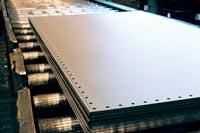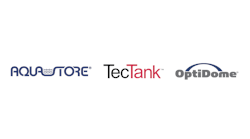Terry Stellema is director of materials engineering for CST Storage. Stellema can be reached at [email protected] or 913.621.3700.
When buying a new storage tank, potential end-users likely will think about size, capacity, cost, turnaround time and ease of construction. They will select proper features and consider maintenance and expected life cycle. But the feature that should be considered most is the tank’s coating—and how it impacts all of the above.
Battling Corrosion
A tank’s coating is the only thing standing between corrosion and liquid. It is important to ask questions of a supplier to confidently choose a coating with proven field performance. Moreover, the coating application process further separates the quality of one tank from another. Depending on the tank’s design, the coating application process will take place at the factory or in the field.
Uncoated steel begins to form a thin layer of corrosion as soon as the raw sheets are formed. Tank manufacturers should remove this layer prior to applying the coating. Some manufacturers utilize chemicals to prepare the surface, which is cost-effective but barely touches the surface. A more vigorous surface preparation (e.g., sandblasting) removes corrosion and roughens the steel surface so that the coating can better grip or adhere to the surface of the steel. A proper sandblast procedure yielding the maximum cleaning and surface profile should meet standards such as NACE No. 2/SSPC-SP 10 Near White Cleanliness to ensure the coating adheres properly.
Once the surface is prepared, the clock is ticking. Flash rust can occur quickly, and the surface becomes vulnerable to environmental contamination. This part of the coating process often is underrated, yet it is critical to ensure the quality of the coating. The length of time between surface preparation and coatings of paint will greatly affect the expected longevity in the field. Some customers include in their specifications that a first coating be applied no more than 15 minutes after the surface preparation has been completed.
Particles from environmental contamination also will affect surface adhesion of the coating. Tank manufacturers may employ significant quality control measures, including cleaning and filtering equipment, to remove particulates from the air so they will not interfere with coating adhesion.
Field- and Factory-Applied Coatings
Tanks that receive coatings in the field should be inspected to ensure that good surface preparation has occurred on the underside of the floor, which is not easy to reach, as well as the underside of the roof, which requires blasting shot upward. Factory-coated tanks will undergo surface preparation as part of their application process at the factory. Good surface preparation includes uniform coverage, even in hard-to-reach spots, and achieving a uniform mill profile for maximum coating adhesion.
Factory-applied coatings are applied to individual tank panels under environmentally controlled conditions. Coatings applied at the factory are monitored closely throughout the process. Two common factory-applied coatings include high-quality glass-fused-to-steel (porcelain enamel) and powdered epoxy.
High-tech epoxy lines control the coating application process by measuring the quality and thickness of the coating, capturing overspray, monitoring particulates in the air and testing for uniformity. Glass-fused-to-steel coatings are applied in layers of two to three coats, including a top coat.
Powdered epoxy coatings are applied electrostatically to ensure uniform thickness and good adhesion to corners and edges. Some epoxy-coated tanks utilize a coat of epoxy on their exterior in lieu of a top coat of urethane. Urethane offers better UV resistance, which results in less chalking and fading.
In the field, tanks often are coated with epoxy using a hand-held sprayer. In some areas, environmental standards require overspray be captured by tenting to prohibit the release of harmful volatile organic compounds into the atmosphere. Field application frequently includes two coats: primer followed by a topcoat (e.g., acrylic polyurethane). It is possible, although difficult, to monitor and control particulates in the air during the coating process. Contamination is a concern, as curing for field-applied coatings is subject to ambient air.
The process of curing the coating varies from tank to tank. Factory-applied coatings may be cured either thermally in temperature-controlled ovens or by ambient air, in the case of epoxy. Glass frit cannot be fused to a substrate in the field, so glass-fused-to-steel coatings are factory applied. Fusing glass to steel requires molecular interaction resulting in a coating, which blends glass and steel such that one cannot be separated from the other. In this process, glass is fused to the steel surface at 1,500°F, which forms a tight chemical comingling of materials.
Some glass-fused-to-steel tank manufacturers fire the panels after two coats are applied, then follow with a third coat and second firing. Advanced tank manufacturers utilize technology that allows for three coats successfully fused together with one firing. This reduces the cost and time required for the coating application, as well as the risk of contamination between coats.
Factory-applied epoxy coatings sometimes are cured by ambient air, but a thermal cure is preferred. Thermal curing occurs when panels pass through curing oven temperatures of 400°F. Beware of tank vendors who claim their epoxy is “fused” to steel, as this is technically impossible.
Field-applied coatings usually rely on ambient air to cure. This method of curing can require up to 72 hours. The ambient air-curing process is subject to weather and environmental conditions, including temperature, humidity, wind and dust.
Testing for Quality
All tank coatings should be tested for quality assurance. Missed spots often are not detectable by the human eye. Rust and corrosion will start at a pinpoint-sized missed spot, or “holiday,” and spread. While corrosion creep will not occur with glass-fused-to-steel coatings, all coatings, including glass, must be tested for missed spots prior to the tank’s first use.
The basic test for holidays utilizes a 12V tester. A wet sponge with an electrical charge is moved across the surface. The metal behind the coating also receives a charge. Wherever the wet sponge touches bare metal, a circuit is completed and the holiday is made known by an audible or visual indicator.
A more stringent test is the high-voltage spark detector. This test uses the material’s dielectric strength to determine the minimal coating thickness. Both a wand and the tank wall receive a charge. If the electrical current reaches bare metal or detects thinly applied coating, a spark appears, showing the exact location. High-voltage defect testing proves the uniformity of the coating over all surfaces, including tough-to-reach areas. Determining thin spots is imperative because thinly applied coating may allow premature corrosion. High-voltage defect testing is not common among tank manufacturers.
Factory-applied coatings often are tested throughout the process. Incremental tests ensure the steel has the proper:
• Profile prior to coating;
• Temperature and pH of the washwater;
• Time between surface preparation and coating (to prohibit flash rust); and
• Temperature of the thermal cure.
For field-applied coatings, both tests may be employed; a high-voltage spark detector test, however, should be requested. During coating application with a hand-held sprayer, it is difficult to ensure uniform application across all surfaces. Without the control measures found within a factory setting, the best scenario includes hiring an independent certified coatings inspector to monitor the coating application process (ensuring proper tenting, surface preparation, checking mill thickness, etc.). Many coatings manufacturers recommend using an NSF-certified inspector. While it may be tempting to inspect coatings yourself, a trained expert will certify that the coating is properly applied, ensuring the longest possible life for the tank.
Choosing a Tank
A tank is only as strong as its coating. The better the coating application process, the longer the tank will last. While it may be tempting to choose a tank based solely on the upfront cost, it is important to research total life-cycle cost of each option. A field-applied coating may require repainting sooner than a
factory-applied coating.
Ask vendors to explain their coating process; ask for data and case histories about how the coating performed over time; ask about maintenance and recoating requirements. Finally, investigate quality control and testing measures used throughout the process.
While most tank manufacturers claim to utilize the best coating, this can be proven only through years of performance. Therefore, audit or visit the factory where the coating will be applied, or visit a site where a tank is receiving a field-applied coating. Here one can validate the steps taken during the coating application process and ensure a tank manufacturer will deliver a tank that will provide long-lasting, durable storage.
Download: Here



